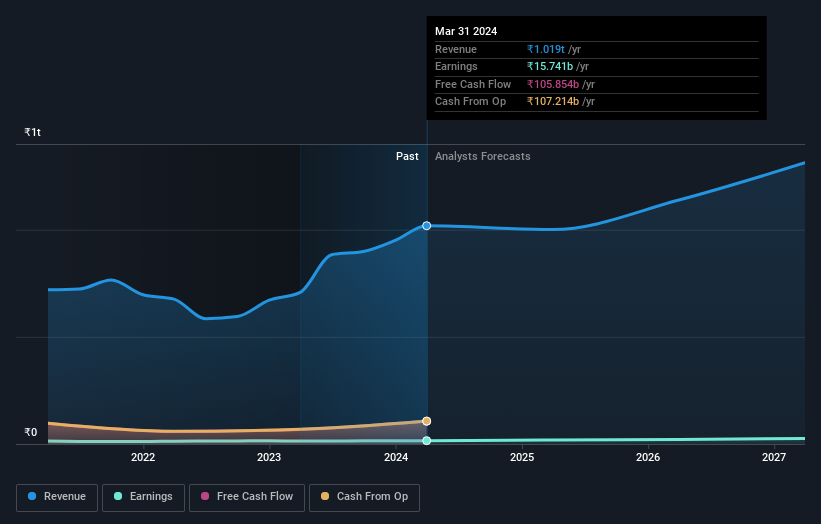HDFC Life Insurance Company Limited Just Beat Revenue Estimates By 12%

As you might know, HDFC Life Insurance Company Limited (NSE:HDFCLIFE) just kicked off its latest annual results with some very strong numbers. It was a positive result, with revenues and statutory earnings per share (EPS) both performing well. Revenues were 12% higher than the analysts had forecast, at ₹1.0t, while EPS of ₹7.31 beat analyst models by 2.1%. Following the result, the analysts have updated their earnings model, and it would be good to know whether they think there's been a strong change in the company's prospects, or if it's business as usual. We thought readers would find it interesting to see the analysts latest (statutory) post-earnings forecasts for next year.
Check out our latest analysis for HDFC Life Insurance

Following last week's earnings report, HDFC Life Insurance's eleven analysts are forecasting 2025 revenues to be ₹1.00t, approximately in line with the last 12 months. Per-share earnings are expected to jump 26% to ₹9.19. In the lead-up to this report, the analysts had been modelling revenues of ₹981.2b and earnings per share (EPS) of ₹8.58 in 2025. The analysts seems to have become more bullish on the business, judging by their new earnings per share estimates.
The consensus price target was unchanged at ₹736, implying that the improved earnings outlook is not expected to have a long term impact on value creation for shareholders. Fixating on a single price target can be unwise though, since the consensus target is effectively the average of analyst price targets. As a result, some investors like to look at the range of estimates to see if there are any diverging opinions on the company's valuation. There are some variant perceptions on HDFC Life Insurance, with the most bullish analyst valuing it at ₹840 and the most bearish at ₹635 per share. The narrow spread of estimates could suggest that the business' future is relatively easy to value, or thatthe analysts have a strong view on its prospects.
Taking a look at the bigger picture now, one of the ways we can understand these forecasts is to see how they compare to both past performance and industry growth estimates. These estimates imply that revenue is expected to slow, with a forecast annualised decline of 1.8% by the end of 2025. This indicates a significant reduction from annual growth of 19% over the last five years. Compare this with our data, which suggests that other companies in the same industry are, in aggregate, expected to see their revenue grow 8.3% per year. So although its revenues are forecast to shrink, this cloud does not come with a silver lining - HDFC Life Insurance is expected to lag the wider industry.
The Bottom Line
The biggest takeaway for us is the consensus earnings per share upgrade, which suggests a clear improvement in sentiment around HDFC Life Insurance's earnings potential next year. On the plus side, there were no major changes to revenue estimates; although forecasts imply they will perform worse than the wider industry. The consensus price target held steady at ₹736, with the latest estimates not enough to have an impact on their price targets.
With that in mind, we wouldn't be too quick to come to a conclusion on HDFC Life Insurance. Long-term earnings power is much more important than next year's profits. We have forecasts for HDFC Life Insurance going out to 2027, and you can see them free on our platform here.
We don't want to rain on the parade too much, but we did also find 1 warning sign for HDFC Life Insurance that you need to be mindful of.
Valuation is complex, but we're here to simplify it.
Discover if HDFC Life Insurance might be undervalued or overvalued with our detailed analysis, featuring fair value estimates, potential risks, dividends, insider trades, and its financial condition.
Access Free AnalysisHave feedback on this article? Concerned about the content? Get in touch with us directly. Alternatively, email editorial-team (at) simplywallst.com.
This article by Simply Wall St is general in nature. We provide commentary based on historical data and analyst forecasts only using an unbiased methodology and our articles are not intended to be financial advice. It does not constitute a recommendation to buy or sell any stock, and does not take account of your objectives, or your financial situation. We aim to bring you long-term focused analysis driven by fundamental data. Note that our analysis may not factor in the latest price-sensitive company announcements or qualitative material. Simply Wall St has no position in any stocks mentioned.
About NSEI:HDFCLIFE
HDFC Life Insurance
Provides individual and group insurance solutions in India.
Proven track record with adequate balance sheet.
Similar Companies
Market Insights
Community Narratives



